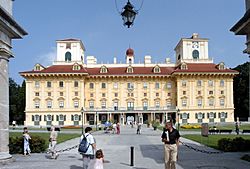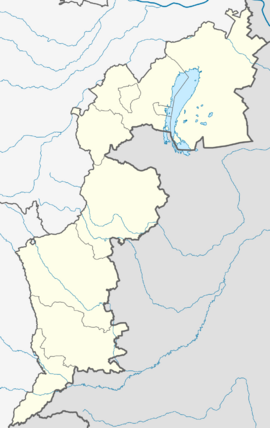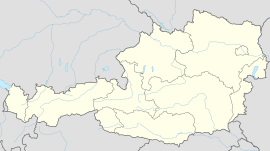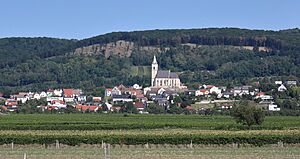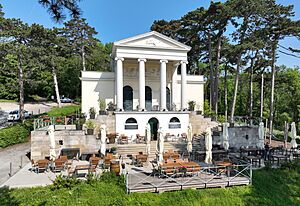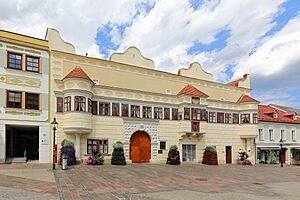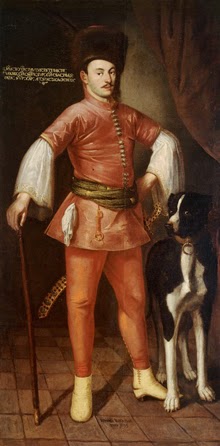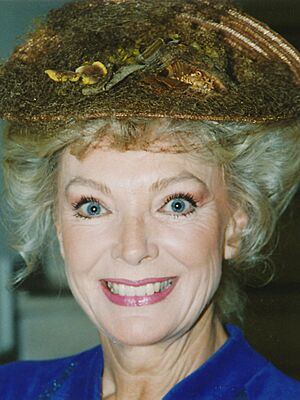Eisenstadt facts for kids
Quick facts for kids
Eisenstadt
|
|||
|---|---|---|---|
|
Clockwise from top: aerial view of the city, state government building, Schloss Esterházy, calvary with Bergkirche
|
|||
|
|||
| Country | |||
| State | Burgenland | ||
| District | Statutory city | ||
| Area | |||
| • Total | 42.88 km2 (16.56 sq mi) | ||
| Elevation | 182 m (597 ft) | ||
| Time zone | UTC+1 (CET) | ||
| • Summer (DST) | UTC+2 (CEST) | ||
| Postal code |
7000
|
||
| Area code | 02682 | ||
| Vehicle registration | E | ||
| Budget | €42.256 million (2021) | ||
| Expenditure | €42.255 million (2021) | ||
| Website | www.eisenstadt.gv.at | ||
Eisenstadt is the capital city of the Austrian state of Burgenland. It is located in Austria, a country in Europe. With about 15,000 people living there (as of 2023), it is the smallest state capital in Austria. The city sits at the bottom of the Leitha Mountains.
For a long time, from 1648 to 1921, Eisenstadt was part of the Kingdom of Hungary. It was also the home of the important Hungarian noble family, the Esterházy family. A famous composer named Joseph Haydn lived and worked here during that time. He was a court musician for the Esterházy family.
After 1921, Burgenland became part of Austria. Eisenstadt was chosen as the capital of this new state in 1925. Today, it is a main center for government services and has three colleges.
Contents
What is Eisenstadt Like?
Eisenstadt is located on a flat area that slopes down to the Wulka river. It is at the southern base of the Leitha Mountains. The city is only about 12 kilometers (7.5 miles) from the border with Hungary.
Parts of Eisenstadt
Eisenstadt is split into three main areas called Ortsteile:
- Eisenstadt-Stadt (this is the main city area)
- Kleinhöflein im Burgenland – a town to the west of the main city
- St. Georgen am Leithagebirge – a town to the east of the main city
The city also has five Katastralgemeinden, which are smaller official land areas:
- Eisenstadt-Stadt
- Oberberg (or Oberberg-Eisenstadt) – the northern part of the city
- Unterberg (or Unterberg-Eisenstadt) – the southern part, including the old Jewish quarter
- Kleinhöflein im Burgenland
- St. Georgen am Leithagebirge
The city is surrounded by the district called Eisenstadt-Umgebung.
Nearby Towns
Some towns close to Eisenstadt include:
- Großhöflein, Müllendorf, Steinbrunn, Neufeld/Leitha, and Ebenfurth
- Hornstein
- Wulkaprodersdorf, Trausdorf/Wulka (near the Wulka river)
What Does the Name Eisenstadt Mean?
The name Eisenstadt means "Iron City." This name was first written down in 1118 as Castrum ferrum. It refers to the history of iron mining and trading in this area.
The first time the town was mentioned in writing was in 1264 as "minor Mortin." This matches its Hungarian name, Kismarton. This name reminds us of Martin of Tours, who is the patron saint of the main church in the city.
A Brief History of Eisenstadt
People have lived in the Eisenstadt area for a very long time. Archeological finds show that people were here during the Hallstatt culture period. Later, Celts and Romans also settled here. Around the year 800, during the time of Charlemagne, people from Bavaria started to settle in the area. In the 11th century, this land became part of the Kingdom of Hungary.
A fortress built here was destroyed by troops from Austria. In 1241, Mongol invaders also destroyed it. In 1373, the Kanizsai family took control of the town. They rebuilt the town walls and built a new fortress between 1388 and 1392. In 1388, Eisenstadt was given the right to hold markets by Emperor Sigismund. This meant it could host important trading events.
The town was under Habsburg rule for many years. However, the Ottoman Empire briefly took Kismarton in 1529 and 1532. This happened during their attacks on the city of Vienna. A big fire destroyed much of Eisenstadt in 1589.
In 1648, the powerful Esterházy family took over. These Hungarian princes greatly changed the city. They built many new buildings, especially their grand castle, Schloss Esterházy. During this time, the city was captured by an army in 1683. It was also damaged by another fire in 1776.
A very important time for the city's art and music began when Joseph Haydn became the Esterházy prince's Hofkapellmeister. This meant he was the director of the court orchestra, composing and performing music. In 1809, French troops occupied Eisenstadt during the Napoleonic Wars. In 1897, the city was connected to the railway system.
After World War I, in 1921, Eisenstadt and the rest of Burgenland became part of Austria. On April 30, 1925, Eisenstadt officially became the capital of the Burgenland state. During World War II, Eisenstadt was bombed. In 1945, Soviet troops captured the city, and it remained under Soviet control until 1955. In 1960, it became the main city for the Roman Catholic Diocese of Eisenstadt.
What to See in Eisenstadt
Important Buildings
- Schloss Esterházy: This is a beautiful castle that belonged to the Esterházy family.
- Schlosspark: The large park around the castle.
- Orangerie: A special building in the park for growing citrus trees.
- Leopoldinentempel: A small, pretty temple in the park.
- Gloriette: This used to be the Esterházy family's hunting lodge.
- City Hall: The building where the city government works.
- Cathedral Bastion and Powder tower: Old parts of the city's defenses.
- Martinkaserne: Military barracks from the 19th century.
Churches and Religious Sites
- Bergkirche: A church on a hill where Joseph Haydn is buried.
- Eisenstadt Cathedral: A beautiful old church from the late Gothic period, dedicated to Saint Martin.
- Franziskanerkirche: A Baroque-style Franciscan church. It holds the burial place of the Esterházy family.
- Krankenhaus Barmherzige Brüder and Barmherzigenkirche Hl. Antonius von Padua: A Baroque hospital and church dedicated to Anthony of Padua.
- Jewish quarter: This area has a long history, from 1732 onwards.
- Private synagogue: Located inside the Austrian Jewish Museum.
- Old and new Jewish cemetery: Burial grounds for the Jewish community.
Museums to Visit
- Haydnmuseum: A museum all about the famous composer Joseph Haydn. He lived in this building from 1766 to 1778.
- Landesmuseum: This is a regional museum that shows the history and culture of Burgenland.
- Austrian Jewish Museum: A museum that tells the story of Jewish life in Austria.
- Diözesanmuseum: A museum for the local Roman Catholic church area.
- Feuerwehrmuseum: A museum about the fire department.
Learning in Eisenstadt
Eisenstadt is a place where you can get a good education. It is home to:
- FH Burgenland: A university of applied sciences.
- PH Burgenland: A college of education for future teachers.
- Joseph-Haydn-Privathochschule Burgenland: A music school named after the famous composer.
Culture and Events
Eisenstadt used to host a special festival for Joseph Haydn, called the Haydn Festspiele. There was also a wine festival, the Fest der 1000 Weine, celebrating local wines. The city also hosted a sports event called the Austrian Open.
Partner Cities
Eisenstadt has "twin towns" or "sister cities" around the world. These are cities that have a special friendship and cultural exchange. Eisenstadt is twinned with:
 Bad Kissingen, Germany
Bad Kissingen, Germany Colmar, France
Colmar, France Manassas, Virginia, United States
Manassas, Virginia, United States Lignano Sabbiadoro, Italy
Lignano Sabbiadoro, Italy Sanuki, Japan
Sanuki, Japan Raleigh, North Carolina, United States
Raleigh, North Carolina, United States Sopron, Hungary
Sopron, Hungary
Famous People from Eisenstadt
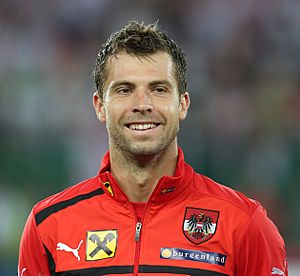
Born in Eisenstadt
- Paul I, Prince Esterházy (1635–1713): The first Prince Esterházy.
- Paul II Anton, Prince Esterházy (1711–1762): A Hungarian prince and soldier who supported music.
- Joseph Weigl (1766–1846): A composer and conductor.
- Josef Hyrtl (1810–1894): A famous anatomist.
- Maria Perschy (1938–2004): A film and TV actress.
- Rudolf Simek (born 1954): An Austrian scholar who studies languages and religions.
- Andrea Fraunschiel (1955–2019): A politician and former local mayor.
Sports Stars
- Johann Dihanich (born 1958): A football player who played many games for Austria.
- Thomas Mandl (born 1979): A football player who also played for Austria.
- Michael Mörz (born 1980): A football player with a long career.
- Andreas Ivanschitz (born 1983): A football player who played many games for Austria.
- Philipp Hosiner (born 1989): An Austrian footballer.
- Marko Daňo (born 1994): A Slovak ice hockey player who won a bronze medal at the 2022 Winter Olympics.
Other Famous Residents


- Joseph Haydn (1732–1809): A world-famous musician, though born elsewhere, he lived and worked in Eisenstadt for many years.
- Ignaz Pleyel (1757–1831): A composer who was a student of Joseph Haydn in Eisenstadt.
- Adam Liszt (1776–1827): A musician and the father of the famous composer Franz Liszt. He played cello under Joseph Haydn.
- Johann Nepomuk Hummel (1778–1837): An Austrian composer and amazing pianist.
- Robert Musil (1880–1942): An Austrian writer who focused on philosophy.
- Fritz Spiegl (1926–2003): A musician, journalist, and humorist who went to school in Eisenstadt.
Images for kids
See also
 In Spanish: Eisenstadt para niños
In Spanish: Eisenstadt para niños





